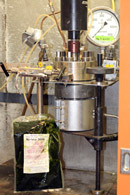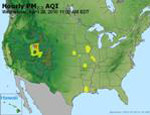
Research by National Science Foundation award winner Peter Sunderland may help engine designers improve the way fuel is injected and burned.
Agency cites increases in anthropogenic greenhouse gas emissions, rising average temperatures, and intense tropical cyclone activity.
By combining conducting and nonconducting domains in the membrane’s nanostructured assembly, researchers improved conductivity performance.
Oil from the offshore well reached Louisiana coastal areas today. The state's governor, Bobby Jindal, declared a state of emergency on Thursday and asked the Defense Department to send up to 6,000 troops to aid in the cleanup.
Participants can create their own agenda using a wiki page.
EPA is sharing 30 years of testing results through an online searchable database called ToxRedDB.
EPA hosts first national building competition to improve energy efficiency
1st Pricing has developed a technology for architects and other designers who use CAD programs.
The agency is erring on the side of caution by paying for water from the Troy system for Halfmoon and Waterford, N.Y.
The U.S. Green Building Council recognizes that there's more than one way to win the gold.

The $2-million American Recovery and Reinvestment Act-funded research combines hydrothermal, catalytic, and biological approaches to make biofuel.
Phase 1 of process includes the removal of several facilities, lagoon areas, and contaminated soils.

Think of the monitoring possibilities: cathodic integrity for corrosion, pump station efficiency, and tank status.

The American Lung Association's annual State of the Air report attributes gains to emissions control equipment for coal-fired power plants and cleaner diesel fuel and engines.
- By L.K. Williams, EPonline
Using renewable energy certificates and power purchase agreements, the company uses energy from the sun, wind, and water flow to power its operations.
Research suggests that endotoxins, which attach to particulate matter, may play a role in chronic inflammation of the heart.
A Pacific Northwest storm system may pull the oil toward Louisiana, Alabama, Mississippi and Florida coasts.
University of Massachusetts and University of Minnesota researchers used methane and carbon dioxide in a single reactor to lower greenhouse gases and make more fuel.